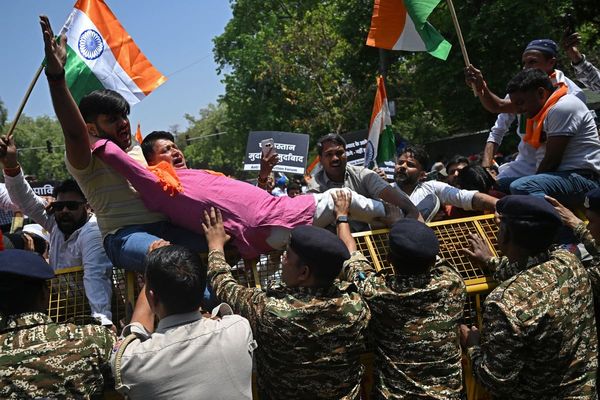
After a 40-year career, Norma Lancaster has been thinking about retirement and planning to move to three days a week in July – but now her plans have changed.
“Because of the volatility … I’m rethinking that. I might stay at work longer,” she says.
Although the ASX clawed back some losses after sliding more than 9% during the fortnight after Donald Trump’s tariff announcements, many retirees – or those approaching it – are still looking aghast at their super balances.
National Seniors Australia (NSA) has called on the government to halve the minimum superannuation draw-down rate, which they say will help slow the depletion of super balances.
On top of this, the organisation says hundreds and thousands of aged pensioners will lose money off their benefits in July, if the new government refuses to continue the freeze on deeming rates.
‘The drop is substantial’
Lancaster works as a business analyst for a major insurer in Melbourne. Had she retired in December, she could have lived self-funded, even if she made it past 100.
But the 63-year-old is invested in high growth – and has lost about 20% of her fund as she had not started to restructure her investments before the tariff announcements.
“The drop is substantial,” she says. “I knew the consequences. I can’t say I was blind to it. So you go, OK, will I stay at work? You’ve almost got to gamble on when you think the market will recover.”
Lancaster says she may work another few years to weather the volatility of the global situation.
“This could potentially push out my retirement five years. I don’t think it will be a quick recovery.”
Lancaster financially helps her three sisters, two of whom she says are at risk of homelessness in the next few years. She had planned to sell her unit and buy a bigger house for them to all live in, which may not happen now.
“I can’t afford not to be contributing, and I need that to work for me, because if I left my job, I’d take a significant cut,” she says.
“I’m kicking myself. I actually feel it’s my own fault, I should have protected myself.”
Worried about the future
Roughly 100,000 to 130,000 Australians retire each year. The creator and host of the Retire Right podcast Glen James says while the past few weeks have been scary for people who are thinking about retiring, it is no cause for panic.
“The key thing to remember is, when you retire, you don’t just move your whole super balance into conservative assets overnight,” he says. “That’s not how it works.
“Super is designed to keep working for you during retirement. That’s why it’s so important to zoom out and understand that your super is a long-term asset, even once you’ve stopped working.”
Even with the current volatility, most portfolios are only showing short-term losses of about 2% to 5% over the past few months, he says.
He says while retirement is a time where one “misstep could cost you tens of thousands of dollars”, the trick is just to have a strategy.
“The biggest issues I see are around uncertainty,” he says. “People often don’t know how much money they’ll need to retire, when they can afford to retire, or how to make the best decisions with what they’ve got.”
It’s not just people thinking about retirement. In the past two weeks, Andrew Mckinney has lost $100,000 off his super. He still says he is fortunate. The 71-year-old retiree owns his own house with his wife in northern Tasmania and hopes to ride out the market volatility, like they did in Covid. But he is starting to worry about the future.
“My main concern is not sort of what’s happening in the market now, because things do stabilise, and things do come back again,” he says. “But I am not sure where it will head … especially if we head towards a world recession.
“In the back of mind is what’s going to happen. Can the world stabilise itself? There’s going to be ongoing pressures, the price of everything being pushed up. Our dollar compared to the States’.”
Chris Grice, the chief executive officer of NSA, says retirees who don’t have time to recoup losses will be impacted the most.
“For older Australians already in retirement, they don’t have the capability or time to make up these losses,” he says.
“Halving the drawdown rate is one way government can help to ease pressures for retirees who are concerned their balances will run out.”
Freeze on deeming rates
Grice also wants to see the freeze on deeming rates continue. Deeming rates are used to estimate the amount of income people are earning on any assets they have – when the rate is increased, the valuation of assets is calculated as higher and welfare is reduced.
While it means the budget bottom line is billions of dollars worse off, the rate has been on hold since 2023 to help recipients handle the cost-of-living pressures.
Lifting it would impact the payments of about 900,000 income support recipients, including about 458,000 age pensioners, 143,000 jobseekers and 103,000 parenting payment recipients.
Neither Labor nor the Coalition would answer questions about if they would continue the pause on deeming rates or halve the withdraw rate.
“Halving the drawdown rate and continuing the freeze on deeming are two practical measures the government can take to show retirees it understands the impact of current market volatility,” Grice says.
“In the lead-up to the federal election, and at a time when Australians are already facing so much uncertainty, we hope all sides of politics heed our call and commit to giving older Australians some certainty over their superannuation.”







